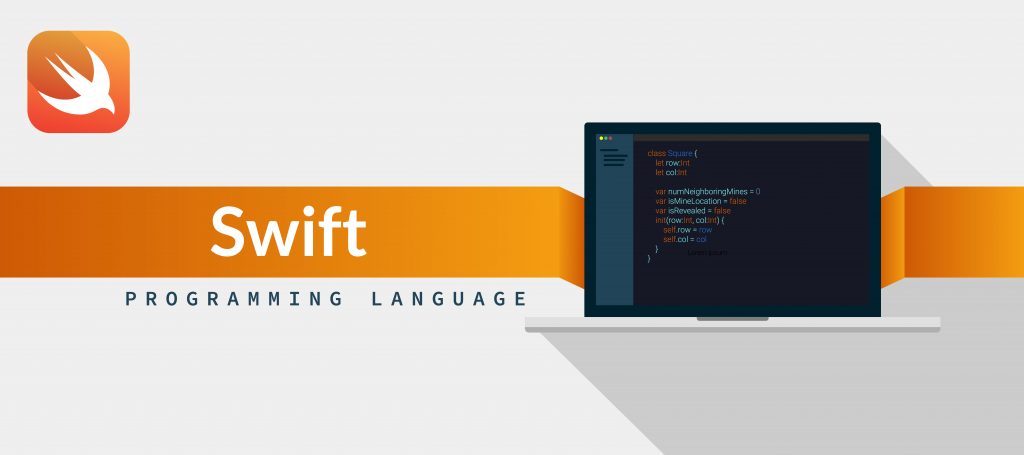Since 2016, iOS is the second operating system for smartphones in the world. The most solvent countries like the UK, USA and France prefer Apple products. It is for this reason that software companies primarily create products for the iOS platform or with a cross-platform expectation. When it became known that Apple Corporation had chosen a new programming language for Swift, a lot of developers took it negatively. Programmers who know other languages, for the most part, were out of work. Everyone wondered: for what reasons is Swift better than its predecessors? Is it worth retraining now?
Swift’s background and history
At its core, Swift is a compiled programming language for Apple devices and for Linux. According to the vice president of software development Craig Federig, the foundation for it was laid in the 1990s on the NeXT platform. It predates the modern corporation. The implementation stage of the implementation began in 2010 by Chris Lattner in cooperation with the company’s developers. Inspired by such widely popular languages as Python, Objective-C, Rust, C# and others.

Swift was presented to the public in 2014 at the WWDC conference. It was marketed as a digestible and modern replacement for Objective-C. According to the corporation’s experts, this new programming language was supposed to attract young specialists in this field who could easily start their journey by studying it. Experienced programmers were offered it as a development of professional logical abilities. At the same conference, a prototype of the language and instructions for use were issued.
A year after the official announcement, Swift has already gained public recognition and, according to the Stack Overflow Developer Survey 2015, has become the favorite language of developers. In 2019, Swift was also in the top twenty. In January 2020, it climbed to 9th place in the TOP, already entering the top ten most popular ones in the world.
Swift benefits
The creators have worked hard to bring the best together in Swift. In general terms, this language is powerful, simple and convenient, and, according to some experts, superior to Objective-C. It is worth considering the benefits in more detail.
Flexible programming
Swift is easy to code due to its simplified syntax and expressiveness and conciseness. Due to these features, the code for performing the assigned tasks has less volume than the one created using Objective-C. This saves developers time and effort by almost two-thirds.
The newly minted adaptation mechanics in applications have reached a higher quality level. If earlier it took a large headquarters of employees and more than a month for implementation, now it takes a week and one specialist.
Scaling
Projects made on this platform are not only quick to produce, but also subject to modifications during operation. This leads to one of the most significant advantages of Swift – that is, the ability to easily scale. Thanks to this, many long-term investors are investing in the PL, and programmers are more willing to learn it. Adapting to the new platform is quick, and almost anyone with the right mindset can learn Swift.
Performance and safety
Initially, this language was developed as a more efficient and faster replacement for its predecessor. For several years of studying its effectiveness, a number of researchers have proven that Swift is 40% faster than Objective-C (it is 2.6 times faster than Objective-C, and Python is more than 8 times faster).
Apple could not release a product that did not meet modern realities in terms of security. As a result, users received a system equipped with perfect typing and code error handling, preventing any interruptions in the software operation. The developers are encouraged to immediately generate “clean” code due Swift’s syntax . It is much easier to eliminate the risks of the formation of low-quality code, to correct its inaccuracies when errors are highlighted and there is instant feedback. At first, the strict coding framework can seem difficult for programmers, but this approach shows its relevance and effectiveness, so it is worth the effort.
Saving memory with dynamic libraries
Software development involves the use of third-party code taken from libraries and frameworks. They are compiled into the code of the program itself. Libraries can be both static and dynamic. The second of the listed ones were presented for iOS by Swift developers at the start of the language development. Unlike static ones, they are not enclosed in code at compile time, due to which the file size does not increase and can also be automatically updated to new versions.
Obtaining third-party code from outside is more time consuming than accessing it in inline and included format. An application can be isolated using static libraries when it is not intended to be dynamic. It all depends on the goals of the developers.

“Friendship” with Objective-C
Swift’s development was based on future prospects, but the programmers realized that at the beginning of its journey language would have difficulty competing with its opponents. Therefore, another Swift’s benefit is its compatibility with Objective-C from the very start. Scenarios can take two turns:
- The code is based on the second, but supplemented with the functions of the first.
- The Swift project has clearly borrowed elements from the second.
They are perfectly compatible, even within the same application. Thus, software designed for subsequent development will function easily and without risk, collecting all the best for solving problems.
Automatic memory management (ARC)
Built-in ARC removes the need to manually track and modify application memory. The process takes place automatically, reducing the formation time. Automatic memory management looks for unnecessary amounts of information that are not used in any way, and can remove them from the user’s view. This is useful for reducing memory usage without sacrificing performance.
Cross-platform
Putting a programming language in the cloud has proven to be a very successful idea. Server Swift can integrate with most common server technologies. The use of this language allows to exchange and reuse the once written code both in the user interface and in the backend. Efforts for developing an application for another platform are reduced many times.
Swift programming language provides support not only for mobile devices, but for all Apple gadgets and systems in general. The language also supports Linux (although the support is not fully calibrated). And official sources claim that all services for Windows will soon be introduced. From the list of the popular platforms, only Android is still closed to this language, since Google developers are promoting their own project Golang in full.
Open source
The creators of Swift from the very moment of the project’s implementation proceeded from the fact that in order to develop a popular and all-round defining programming language, it is necessary to make it open to everyone. With support from Apple and IBM, Swift has acquired a very active open source community. Users gave good feedback, thanks to which it was possible to quickly find imperfections and shortcomings, and quickly eliminate them, adding new features and technologies.
Disadvantages of Swift
Despite the abundance of positive aspects, Swift also has significant disadvantages. Speaking briefly, we can note the limited possibilities of the development itself. This language works only on Mac (the code can be created on Windows, but the compilation is available only on Apple computers), the acquisition of which may turn out to be unaffordable. Without the right device, you have to use a virtual machine, but such development cannot guarantee success.
Young language
All the efforts of Apple could not be enough to release the project in perfect condition. Although programmers regularly report problems and solve them as soon as possible, every now and then new difficulties appear. This is normal for such a young programming language, but you will have to wait some more time to fix all the roughness.
Lack of backward compatibility
Developers often complain about the lack of backward compatibility. Given the constant development and modification of Swift, incompatibility with older versions hits the software developers hard. We have to implement projects for the updated version practically from scratch. However, this problem has been diligently corrected.
Also Swift only works with iOS7 and later OS versions. And at the moment, more than 5% of Apple devices run on early operating systems.
Lack of qualified personnel
The Swift community is growing and developing every year while being very active. But compared to other popular languages, it is still small in number. An independent survey conducted by Stack Overflow in 2018 showed that of 80,000 programmers, only 8.1% use Swift in their work. And many of those surveyed had very little experience of working with it. The percentage has increased over the past two years, but the demand for specialists in this industry still does not find a sufficient number of experienced and intelligent job seekers.
Limited interaction with IDEs and foreign tools
Compared to its peers, Swift has got a relatively small number of tools, options, and libraries. Some of them stop working in newly minted versions of the language. Due to frequent updates, the user cannot always find solutions and tools suitable for the task. The use of language is very difficult, as the features and good solutions of the previous iteration do not carry over to the new one. Xcode and other IDEs lag far behind in terms of language support.
IDE for Swift
IDE is essentially an integrated development environment. In interaction with the PL, this aspect is most important. Consider environments suitable for Swift.
Apple IDE Xcode
The Xcode environment created by Apple is not suitable for every situation, although it will be an excellent solution for most common tasks. But as soon as it becomes necessary to combine the advantages of Swift programming language with JavaScript or other platforms, Xcode turns into a primitive text editor with limited options.
This IDE has many handy features to make development easier. These include support for auto-fill, an ergonomic interface, and more.
Atom
Atom is a simple editor that allows you to create projects for different platforms using many programming languages. It is a basic IDE, but in the meantime it has a wide range of open source packages that are created by the GitHub community. These aspects make it possible to set up an environment for cross-platform development with autocomplete options, convenient multifunctional navigation, and more.
AppCode
AppCode IDE is intended for Apple OS products and is created by JetBrains. In many ways, the functions are similar to Android Studio, but in general the product is aimed at improving the productivity of code generation using a set of convenient refactoring tools. Because of these features, projects often use two IDEs together: AppCode and Xcode. The first option is limited in terms of capabilities, since it does not have storyboards, application testing, etc., and it is not yet distributed free of charge.
Python or Swift?
These programming languages significantly differ in terms of concept, but still they have a number of similarities. Both options are easy to use, have an easy-to-learn syntax, and make errors easy to find and fix. Programmers are happy to use their wide functionality, but they utilize it to solve different problems. They are also multi-paradigm. Each comes with a large number of instructions, due to which the languages are simple enough to learn. Everyone has a convenient learning environment:
- Python IDLE.
- Swift’ Playground.
As mentioned at the beginning of the article, there is one fundamental difference between Python and Swift: the performance of the former is 8 times less than that of the latter. Apple tried to overtake strong opponents in nuances that could be significantly improved. Therefore, the very essence of Swift development was to work quickly on software.
Since the demand for Python is slightly higher even today, the number of programmers who own it is several times greater than Swift specialists.

It is necessary to choose a language for your goals deliberately, analyzing the goals. Swift is ideal for creating software for your development company, but the second option is more universal. Although it is most often used in the backend of project development.
Objective-C or Swift?
It is important to understand that the choice of a PL is a decision of specialists, and is made up of preferences, skills and experience in working with different options. You should not urgently switch to Swift in case there is a lot of work on the project and much more experience in Objective-C. Learning will take time and a lot of effort, even if the language is quite simple. The latter is suitable for developing applications that should work on both old and new operating systems, because as stated earlier, Swift does not work with operating system iterations below 7.
Large projects need to be resilient and stable, and young Swift is not always up to the task. Since there is no upgrade to the new version, you often have to rewrite the code. This is fine for a small application, but for a large commercial project it is still better to do it on a more confident analogue.
Swift is a great choice for learning, but at the moment its libraries are not as large as those of the competitors. Objective-C has access to both C and C++ databases. Thus, now its capabilities exceed its young counterpart, but the performance leaves much to be desired.
Is Swift the programming language of the future?
Although Swift is new and has several weaknesses, its success is undeniable.
The implementation of this platform will intensify as the segment of the apple market is profitable. And where there is finance, there are prospects. At the moment, there can be no question that this language will oust its main competitors from the market, but in the future this is not just possible, but expected. At least when it comes to Objective-C.
Conclusion
Creating software for various Apple operating systems is an incredibly promising industry in which you can still find a place for yourself. At the same time, it seems unlikely to break out in the TOP in the Android application market, since large companies with hundreds of thousands of dollars for marketing promotion have already completely seized the direction. But for iOS, small developer companies can still create something meaningful and get huge feedback.
As a conclusion, it is worth noting that many programmers prefer other programming languages such as Objective-C or Python, and they have their advantages, but still you should not be limited to them. Swift is separated from capturing the market only by time and solving minor problems, so it makes sense to pay some attention to it. Old programming languages will fade into the background over time, and newcomers will totally seize the influence in the future.
NIX Solutions’ team of creative and courageous engineers will help to bring all your ideas to life, aiding from the very beginning of development and choosing the right language all the way to the final successful launch of the application. If an app needs support and analysis, please contact us to evaluate it.
